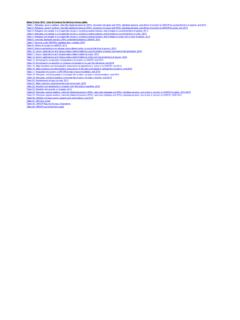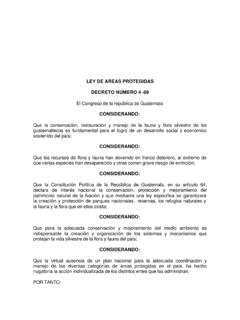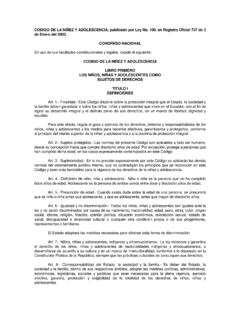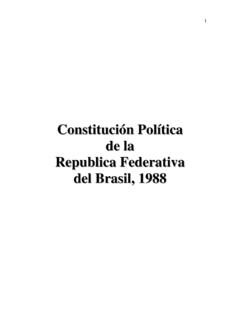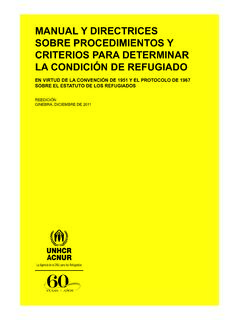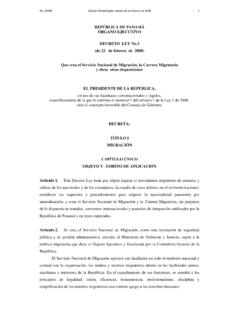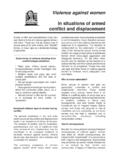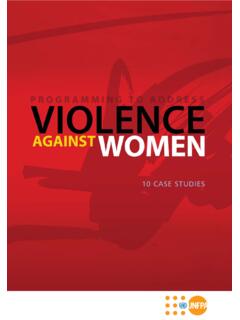Transcription of 16 days of activism against gender-based violence campaign
1 BRIEFING NOTE 16 Days of activism against gender-based violence campaign Americas Region 25 November 10 December 2018 As with previous years, this year UNHCR and its partners in the Americas planned and engaged in activities to highlight the 16 Days of activism For the Elimination of gender-based violence against women around the Americas region. The 16 Days of activism against gender-based violence is an international campaign originating from the first women s Global Leadership Institute.
2 16 Days, as it has become known, was launched and continues to be coordinated by the Center for women s Global Leadership. 1 About the 16 days of activism campaign The dates for the campaign were chosen to link violence against women and human rights and emphasize that gender-based violence against women is a violation of human rights: since 1991, the campaign takes place annually from November 25, the International Day against violence against women to December 10, International Human Rights Day.
3 The 16 Days campaign is an organizing strategy for individuals and groups around the world to call for the elimination of all forms of gender-based violence against women and to: raise awareness about gender-based violence against women as a human rights issue at the local, national, regional and international levels strengthen local work around gender-based violence against women establish a clear link between local and international work to end gender-based violence against women provide a forum in which organizers can develop and share new and effective strategies demonstrate the solidarity of women around the world organizing against gender-based violence against women create tools to pressure governments to implement commitments to eliminate gender-based violence against women1 In
4 The Americas, the 16 Days of activism campaign aims to raise awareness on SGBV as a widespread social, health and economic issue in all corners of the world rooted in gender inequality and unequal power relations. SGBV, wherever it is found, can BRIEFING NOTE be a consequence and also a cause of forced displacement and affects families as well as entire communities. In the last years, campaigns promoted by survivors and activists have reached an increasing number of people.
5 Campaigns such as #MeToo, #TimesUp, #Niunamenos, #NotOneMore, #BalanceTonPorc highlight that while the names and contexts may differ across geographic locations, women and girls everywhere are experiencing extensive abuse and their stories need to be brought to light. The UNiTE campaign s global advocacy theme in 2018 was: Orange the World: #HearMeToo The Situation in the Americas There has been a significant increase in the number of people fleeing violence in Latin America, including from sexual and gender-based violence and persecution.
6 The countries of the North of Central America continue suffering high levels of violence stemming from gangs and other organized criminal groups. Since mid- October 2018, several organized groups of people, caravans , from the NCA region have been traveling north in hopes of reaching Mexico and the , increasing the risk of SGBV along the way. The number of refugees and asylum seekers from Venezuela has also increased. Since 2015, more than million Venezuelans have left the country fleeing the ongoing political and socio-economic situation2.
7 Many Venezuelans in the region remain in an irregular situation making them particularly 2 3 2017 internal displacement figures by country vulnerable to exploitation, trafficking, sexual abuse, and xenophobia. In Colombia, besides having one of the highest numbers of IDPs in the world3, 6,509,000 as of December 2017, caused by the armed conflict, they are also managing the arrival of 1 million of Venezuelans in the borders area and large cities4. The deterioration of the situation in Nicaragua since April 2018 has led to thousands of Nicaraguans fleeing mounting political tensions, violence , and serious human rights violations.
8 The number of asylum applications by Nicaraguans registered in the NCA countries has reached nearly 15,000. SGBV and UNHCR Sexual violence and exploitation continue, highly affecting the displaced population in the Americas region. Honduras. women in a march against SGBV as part of 16 Days commemorations. UNHCR in the Americas works to reduce and mitigate the risk of SGBV through prevention and response interventions organized in partnership with communities, NGOs, government 4 Update of UNHCR s operations in the Americas - Executive Committee of the High Commissioner s Programme BRIEFING NOTE counterparts and host populations in countries of origin, transit or destination, always prioritizing age, gender and diversity.
9 Community-based, survivor-centered and rights-based approaches. UNHCR works in building the capacity of those working with SGBV to improve prevention and response to SGBV cases in the region and organizes and supports events that aim to raise awareness. Across the Americas region, UNHCR promotes a multi-sectoral approach to prevention and response to SGBV situations in partnership with many organizations such as government, civil society, others UN agency and civil society. This interagency dynamic improves and enhances the scope of SGBV work.
10 Regional Safe Spaces Network (RSSN) The Regional Safe Space Network was established in the Americas region in 2017 with the support of UNHCR, to facilitate the disclosure of SGBV and other serious protection incidents and to promote access to standardized services throughout the displacement cycle across countries. A regional RSSN workshop was organized as a contribution to the 16 Days of activism campaign . The workshop launched a toolkit to promote common standards and tools to foster cross-border coordination in the North of Central America and the countries affected by the Venezuelan situation, especially to be used in SGBV and Child protection case management.
